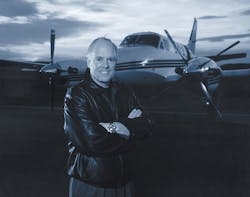After 18 years leading the National Air Transportation Association (NATA), president James Coyne announced last March that 2012 would be his last year.
Coyne spoke to airport business recently; following are edited excerpts:
airport business: Describe some of the biggest changes that have occurred in the industry during your tenure?
James Coyne: One of my great interests has always been to make the industry as friendly to our customers and pilots as we possibly can, and to encourage more people to become pilots and to charter airplanes — to encourage more people to own and operate airplanes.
Anything that is done that creates a barrier between a customer and our industry is a bad thing. And clearly 9/11 has created many barriers.
People used to be able to go to an airport and talk to a pilot and feel that they were experiencing the same thrill of aviation that the Wright Brothers or Lindbergh or Neil Armstrong first felt — and now to see airports surrounded by security fences and sophisticated surveillence systems … and the assumption that there is some great act of violence about to take place — that has really been something I have been very worried about.
I hope that in this second decade after 9/11, we can bring back some reason … but many people in the airport industry have signed on to a very rigorous security environment that may meet some theoretical concerns about what a terrorist might do — but on the other hand, I think it’s really becoming counterproductive and is discouraging passengers, customers, and pilots.
I consider that to be the most difficult thing for our future. We have got to make it easier for people to get involved in our industry.
ab: How about in relation to flight restrictions, and air traffic control?
Coyne: TFRs are a big problem … we have all of these restrictions on airspace, and we have always been frustrated that the airlines can fly in and out of these TFRs without any difficulty, and yet charter operators and others who meet all the requirements of the 12/5 rule have a hard time getting into these restricted areas. It’s just one more thing that makes it hard for us to meet the needs of our customers.
Another thing that is very frustrating to me is the continued almost inept failure of the NextGen ATC modernization. I sat on the ground in Lincoln, NE, on a beautiful VFR day a few weeks ago for a ground hold on a flight to Washingto, D.C. It was VFR weather all the way, and we have these arbitrary airspace restrictions that hearken back to 50-year-old technology.
It’s very frustrating for someone who makes the investment in an airplane to save time, and then they find out that the inefficiency of our Federal government’s air traffic control system defeats the purpose sometimes.
The most amazing thing that has happened in the last 18 years is the digital transformation that’s affected so much of our industry. All of these new technologies [online training programs; webinars; digital connectivity] have really been wonderful for our members and the aviation community.
My number one feeling at this point after 18 years is a real deep appreciation to the folks who have given me this opportunity — the people and staff that I have worked with, our members, journalists, and many people in government that I have gotten to know better because of this experience.
ab: What are your plans for life after leading NATA?
Coyne: I’m hoping to be very active as a consultant in transportation, aviation, and airport issues. I’ve done a lot of consulting; I started out after graduate school more than 40 years ago as a transportation consultant, and I’ve been involved in it ever since.
ab: What are the prospects for recovery in business aviation activity?
Coyne: Statistically, our industry has closely followed corporate profits — when profits improve, generally speaking, our industry does better. I think most observers are saying right now that there’s a lot of ‘wait-and-see’ going on in corporate America.
They are waiting to see the political outcomes of this year; they are waiting to see what new regulations are going to be affecting investment and taxes; waiting to see what the new health care law is going to be like; waiting to see whether Congress goes off a cliff with the whole question regarding the budget mandates that may occur under sequestration in January.
So there’s a real — probably more dramatic than ever before — wait-and-see attitude in corporate America. Most corporations today are relevantly flush with capital; they can borrow money with some of the lowest interest rates in history.
So if we can get these uncertainties out of the way, I think there’s a real good chance that corporate America – forgive the pun – could really take off in 2013.
ab: This being a presidential election year, what is your outlook for the industry? Who's better for GA?
Coyne: I’m optimistic, especially if the election this year produces a more business-friendly government.
Certainly from the point-of-view of helping corporations and businesses grow, I think a Mitt Romney victory would be viewed as something that would be very helpful and favorable to the future of American businesspeople — holding their taxes down; and stop condemning successful people.
Much of aviation’s growth has always been coupled with the most successful people in America, and we’ve had a period of time here where there has been a lot of criticism of the top so-called '1 percent' in America … and so what’s happened is you criticize and threaten this 'top 1 percent', and they hunker down, stop investing, and stop taking risks.
I think if a Romney administration was much more supportive of the people who are creating jobs and building businesses, that would be good for aviation.
Thanks for your interest,
BDM

